Nanocnide simingshanensis (Urticaceae), a New Species from Zhejiang, Eastern China
Abstract
1. Introduction
2. Materials and Methods
2.1. Field Work and Sampling
2.2. Morphological Analysis
2.3. DNA Extraction and Sequencing
2.4. Data Analysis
3. Results
3.1. Morphological Analysis
3.2. Phylogenetic Analysis
4. Discussion
Taxonomic Treatment
Author Contributions
Funding
Data Availability Statement
Conflicts of Interest
References
- Christenhusz, M.J.M.; Byng, J.W. The number of known plants species in the world and its annual increase. Phytotaxa 2016, 261, 201–217. [Google Scholar] [CrossRef]
- von Blume, C.L.R. Museum Botanicum Lugduno-Batavum, Sive, Stirpium Exoticarum Novarum vel Minus Cognitarum ex Vivis Aut Siccis Brevis Exposition; E.J. Brill: Lugdunum-Batavorum, The Netherlands, 1856; p. 154. [Google Scholar] [CrossRef]
- Weddell, H.-A.; Nanocnide; de Candolle, A.P. Prodromus Systematis Naturalis Regni Vegetabilis; Sumptibus Sociorum Treuttel et Würtz: Paris, France; Nabu Press: Charleston, SC, USA, 1869; Volume 16 Pt 1, pp. 68–69. [Google Scholar]
- Migo, H. Duae Novae Plantae Chinenses. Trans. Nat. Hist. Soc. Formosa 1934, 24, 386–387. [Google Scholar]
- Jin, X.F.; Zhang, J.; Lu, Y.F.; Yang, W.W.; Chen, W.J. Nanocnide Zhejiangensis sp. nov. (Urticaceae: Urticeae) from Zhejiang Province, East China. Nord. J. Bot. 2019, 37, e02339. [Google Scholar] [CrossRef]
- Léveillé, A.A.H. Contribution jubilaire a la flore du Kouy-Tchéou. Bull. Société Bot. Fr. 1904, 51, 143–146. [Google Scholar]
- Qiu, H.; Gilbert, M.G. Euphorbiaceae. 40. Acalypha. In Flora of China; Wu, Z.-Y., Peter, H.R., Hong, D.-Y., Eds.; Science Press: Beijing, China; Beijing & Missouri Botanical Garden Press: St. Louis, MI, USA, 2008; Volume 11, pp. 251–255. [Google Scholar]
- Pei, C. The vascular plants of Nanking IV. Contributions from the Biological Laboratory of the Science Society of China. Bot. Ser. 1934, 9, 141–188. [Google Scholar]
- Chen, C.J.; Friis, I.; Wilmot-Dear, C.M. Urticaceae. In Flora of China; Wu, Z.Y., Raven, P.H., Hong, D.-Y., Eds.; Science Press: Beijing, China; Beijing & Missouri Botanical Garden Press: St. Louis, MI, USA, 2003; Volume 5, pp. 76–189. [Google Scholar]
- Tateishi, Y. 5. Nanocnide Blume. In Flora of Japan IIa; Iwatsuki, K., Boufford, D.E., Ohba, H., Eds.; Kodansha: Tokyo, Japan, 2006; pp. 89–90. [Google Scholar]
- Aoki, S.; Li, P.; Matsuo, A.; Suyama, Y.; Ito, M. Molecular phylogeny and taxonomy of the genus Nanocnide (Urticaceae) with particular attention to the Ryukyu Islands endemic N. lobata. Phytotax. 2023, 607, 23–40. [Google Scholar] [CrossRef]
- Wu, Z.Y.; Monro, A.K.; Milne, R.I.; Wang, H.; Yi, T.S.; Liu, J.; Li, D.-Z. Molecular phylogeny of the nettle family (Urticaceae) inferred from multiple loci of three genomes and extensive generic sampling. Mol. Phylogenet. Evol. 2013, 69, 814–827. [Google Scholar] [CrossRef] [PubMed]
- Kim, C.; Deng, T.; Chase, M.; Zhang, D.-G.; Nie, Z.-L.; Sun, H. Generic phylogeny and character evolution in Urticeae (Urticaceae) inferred from nuclear and plastid DNA regions. Taxon 2015, 64, 65–78. [Google Scholar] [CrossRef]
- Blattner, F.R. Direct amplification of the entire ITS region from poorly preserved plant material using recombinant PCR. Biotechniques 1999, 27, 1180–1186. [Google Scholar] [CrossRef] [PubMed]
- White, T.J.; Bruns, T.; Lee, S.; Taylor, J. Amplification and direct sequencing of fungal ribosomal RNA genes for phylogenetics. In PCR Protocols: A Guide to Methods and Applications; Academic Press Inc.: San Diego, CA, USA, 1990. [Google Scholar] [CrossRef]
- Burland, T.G. DNASTAR’S Lasergene sequence analysis software. Methods Mol Biol. 2000, 132, 71–91. [Google Scholar] [CrossRef] [PubMed]
- Katoh, K.; Standley, D.M. MAFFT multiple sequence alignment software version 7: Improvements in performance and usability. Mol. Biol. Evol. 2013, 30, 772–780. [Google Scholar] [CrossRef] [PubMed]
- Talavera, G.; Castresana, J. Improvement of phylogenies after removing divergent and ambiguously aligned blocks from protein sequence alignments. Syst. Biol. 2007, 56, 564–577. [Google Scholar] [CrossRef] [PubMed]
- Kalyaanamoorthy, S.; Minh, B.Q.; Wong, T.K.F.; von Haeseler, A.; Jermiin, L.S. ModelFinder: Fast model selection for accurate phylogenetic estimates. Nat. Method. 2017, 14, 587–589. [Google Scholar] [CrossRef] [PubMed]
- Nguyen, L.T.; Schmidt, H.A.; von Haeseler, A.; Minh, B.Q. IQ-TREE: A fast and effective stochastic algorithm for estimating maximum-likelihood phylogenies. Mol. Biol. Evol. 2015, 32, 268–274. [Google Scholar] [CrossRef] [PubMed]
- Minh, B.Q.; Nguyen, M.A.; von Haeseler, A. Ultrafast approximation for phylogenetic bootstrap. Mol. Biol. Evol. 2013, 30, 1188–1195. [Google Scholar] [CrossRef] [PubMed]
- Anisimova, M.; Gil, M.; Dufayard, J.F.; Dessimoz, C.; Gascuel, O. Survey of branch support methods demonstrates accuracy, power, and robustness of fast likelihood-based approximation schemes. Syst. Biol. 2011, 60, 685–699. [Google Scholar] [CrossRef] [PubMed]
- Guindon, S.; Dufayard, J.F.; Lefort, V.; Anisimova, M.; Hordijk, W.; Gascuel, O. New algorithms and methods to estimate maximum-likelihood phylogenies: Assessing the performance of PhyML 3.0. Syst. Biol. 2010, 59, 307–321. [Google Scholar] [CrossRef] [PubMed]
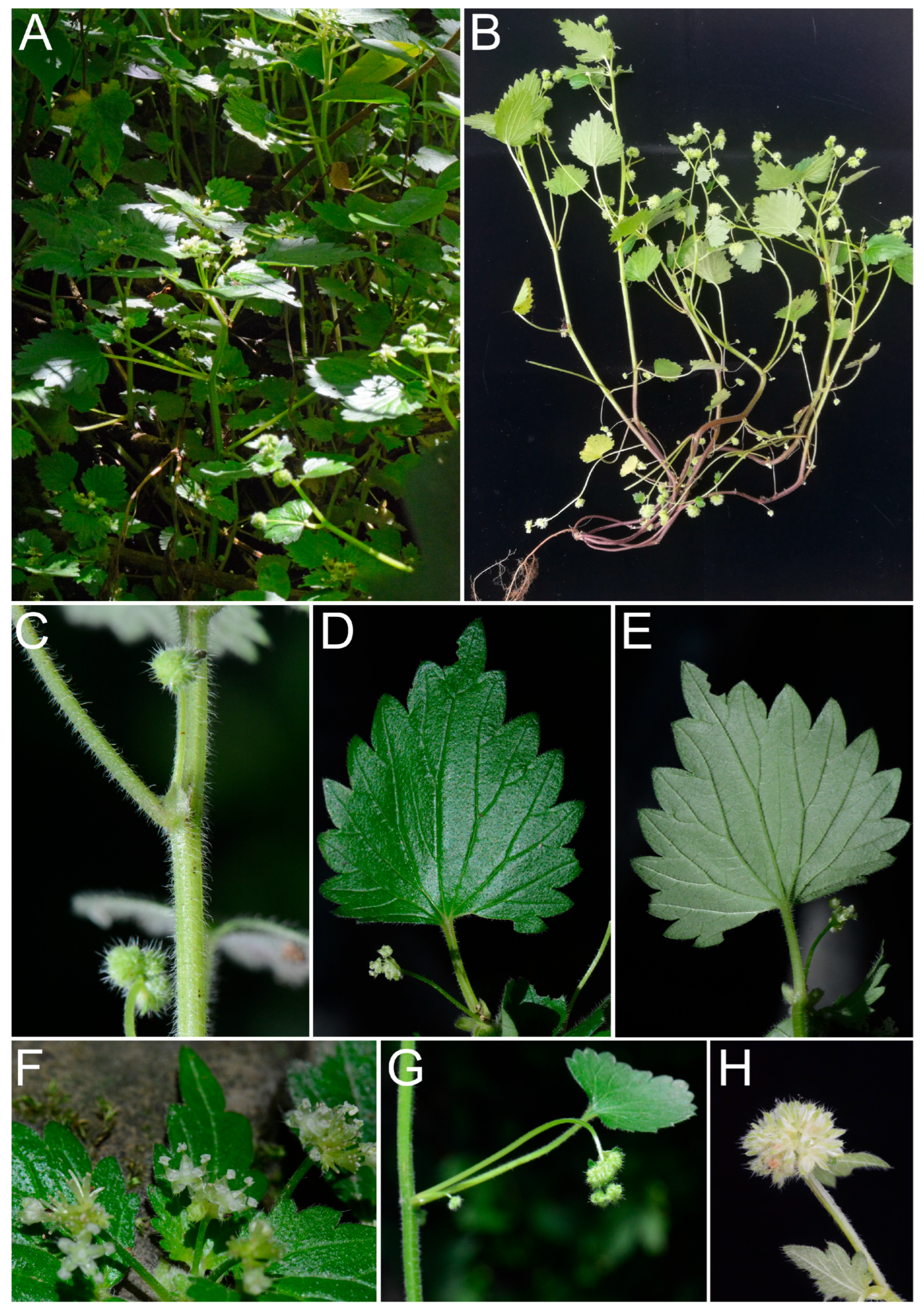
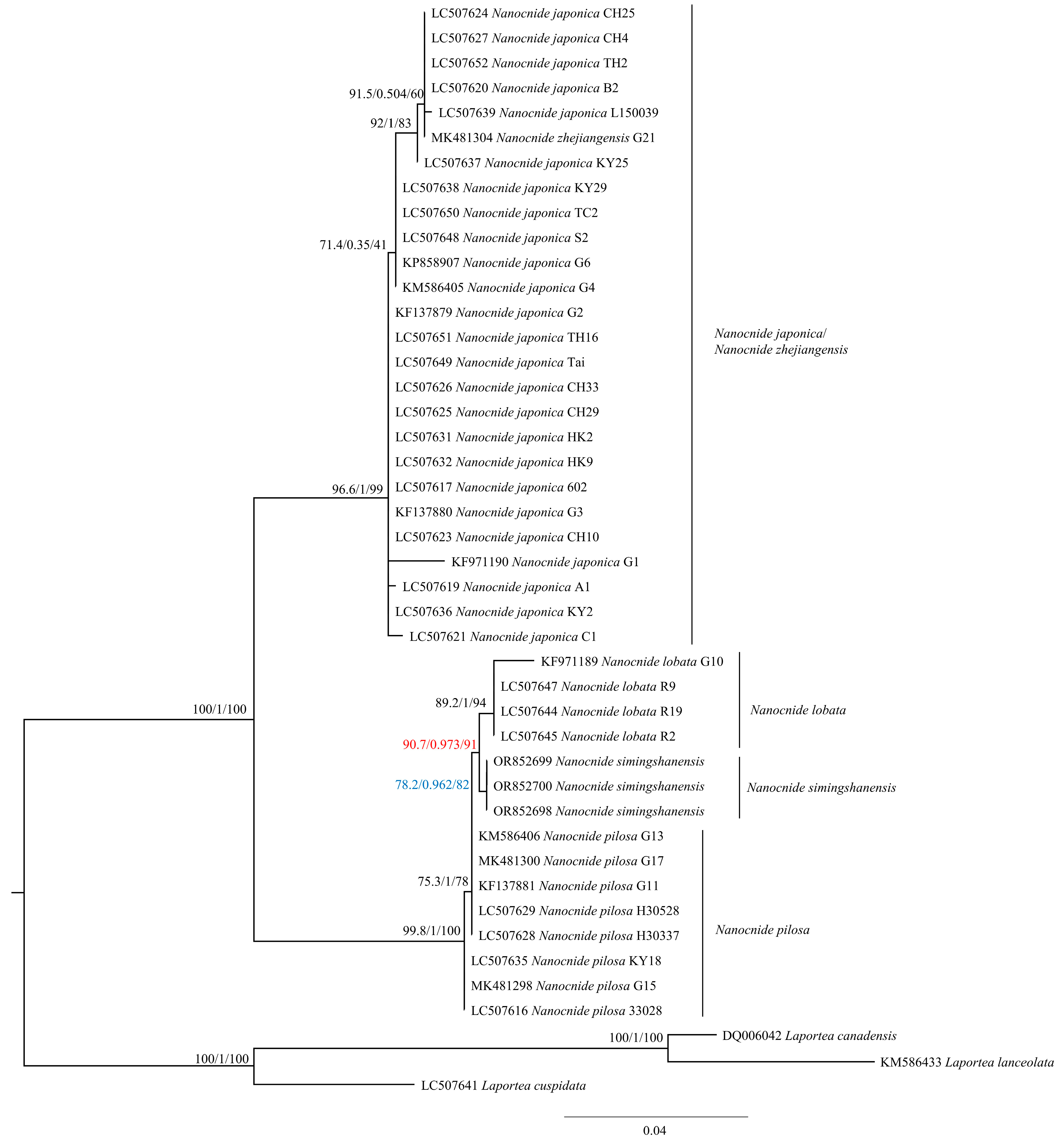
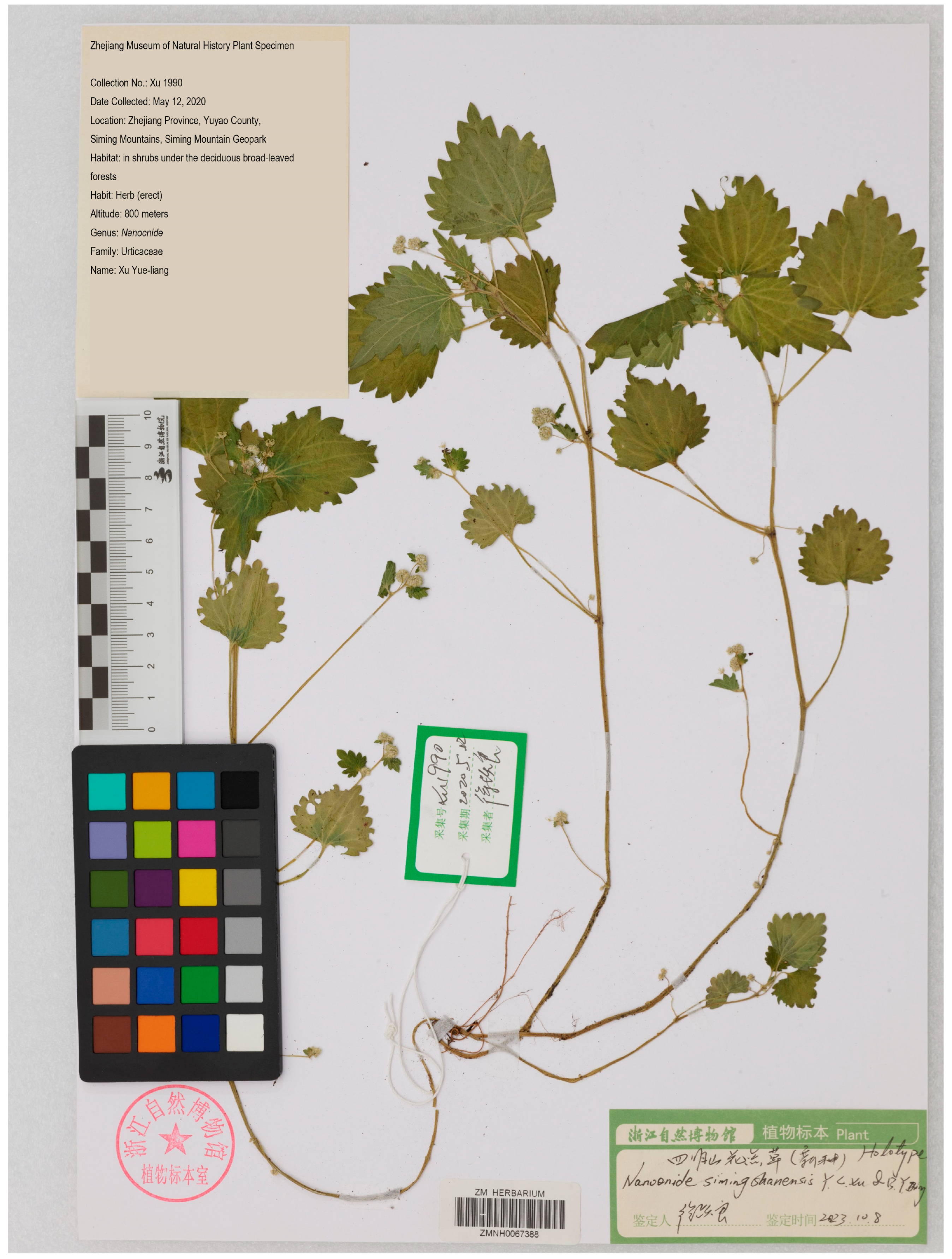
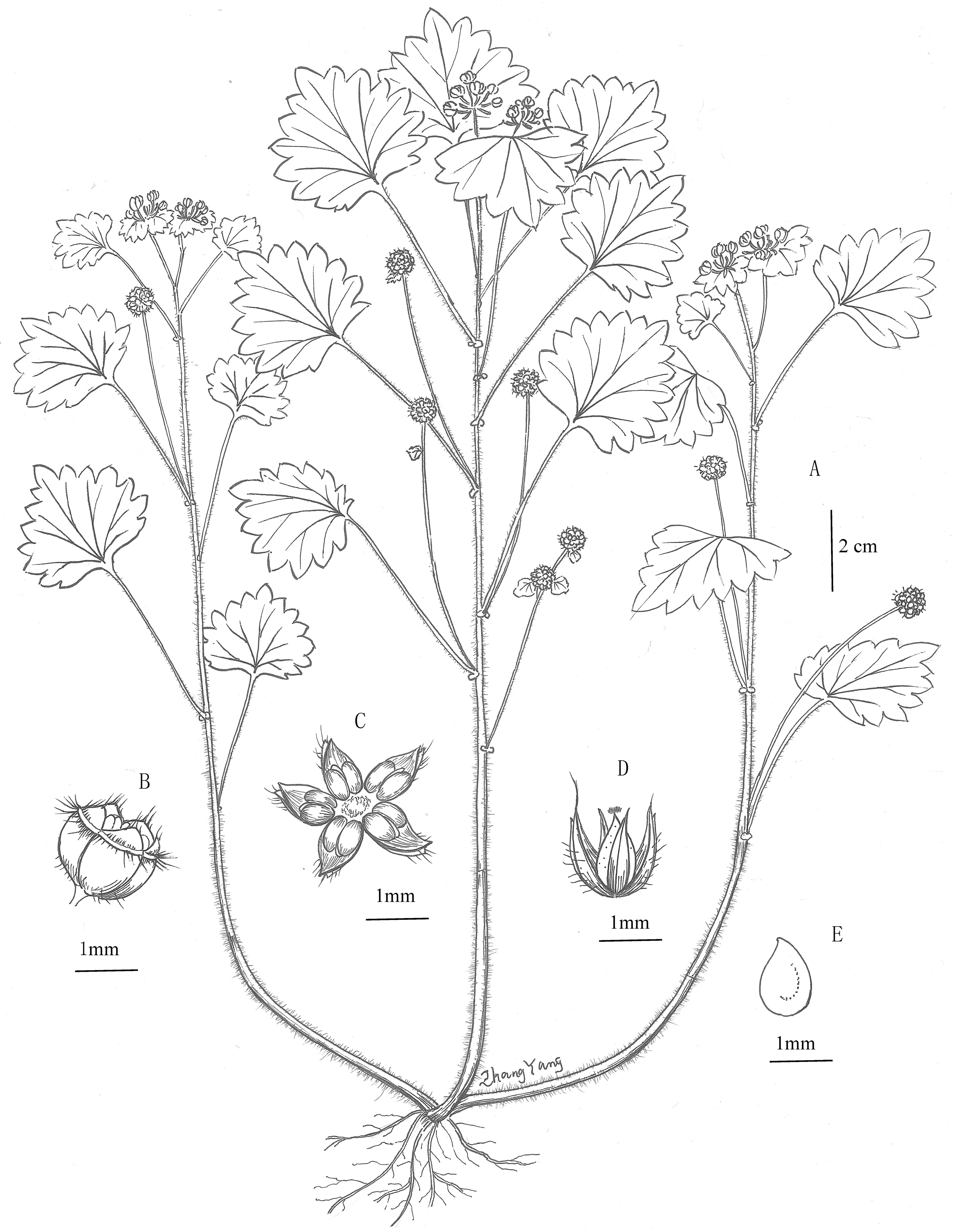
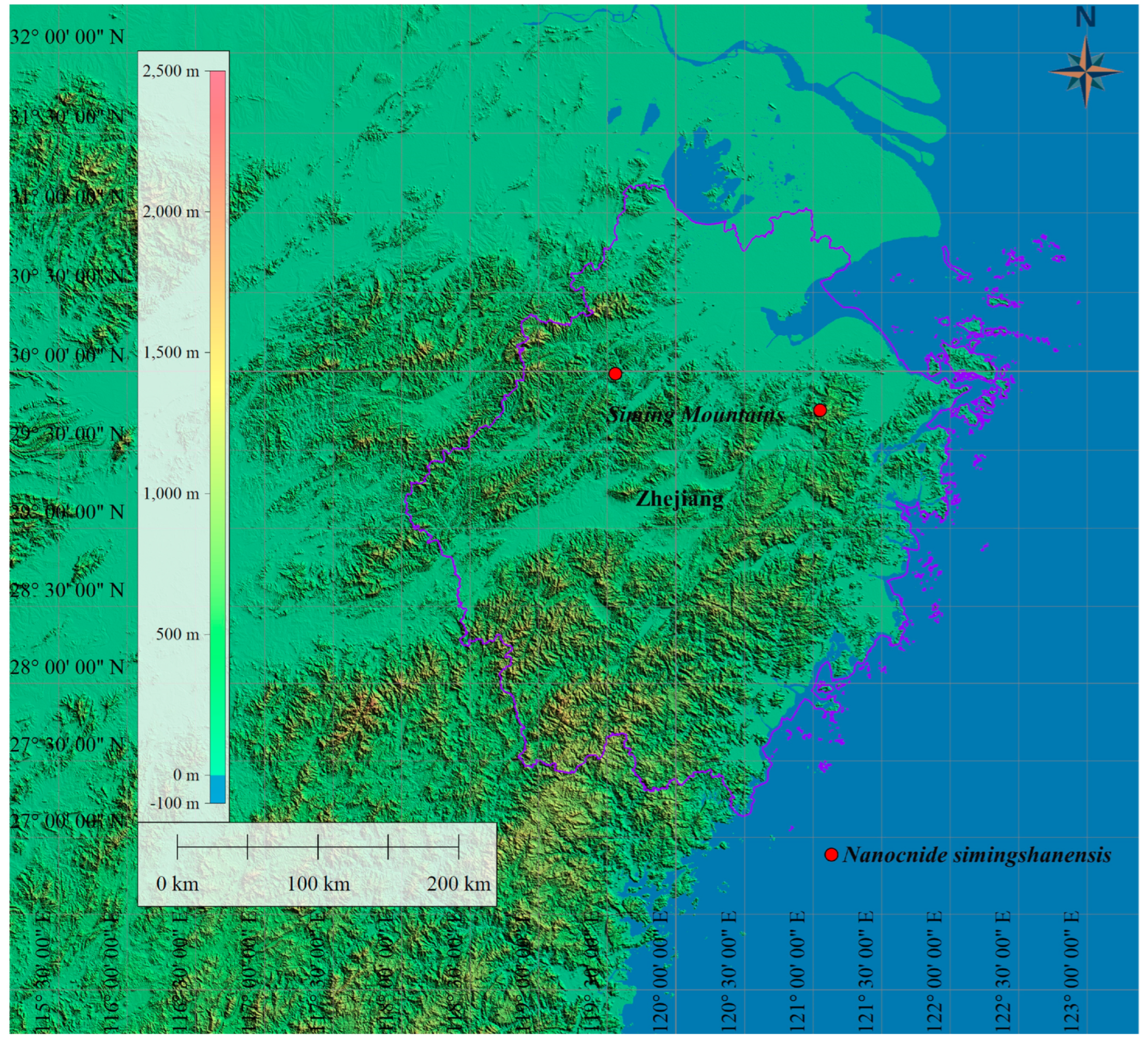
| Characteristics | N. simingshanensis # | N. pilosa *,$ | N. lobata $ | N. japonica *,$ | N. zhejiangensis @ |
|---|---|---|---|---|---|
| Stems | Erect, unfolded hirsute | Diffuse, retrorse hirsute | Diffuse, retrorse hirsute | Erect, antrorse hirsute | Erect, glabrous |
| Leaf blade (cm) | Broadly ovate or flabellate, 2.5–5 × 2.5–5, margins unequally 5–9-crenate per side | Broadly ovate, triangular-ovate, or subflabellate, 1.5–2 × 1.3–1.8, margins unequally 4–5(-7)-crenate per side | Flabellate to ovate, 0.6–1.5 × 0.6–1.5, margins 1–2-lobes per side, rarely unlobed | Blade triangular-ovate or rhombic-ovate 1.5–4 × 1.3–4, margins deeply 4–7-crenate-dentate per side | Triangular-ovate, broadly ovate or flabellate, 0.8–4.0 × 1.0–3.5, margins deeply 3–9-crenate per side |
| Petioles (cm) | 1.5–5.5 | 0.8–1.8 | 0.3–1 | 1–5 | 0.7–4.5 |
| Male inflorescences | Glomerules, born in distal axils, shorter than leaves, peduncles 0.5–4 cm | Glomerules, born in distal axils, shorter than leaves, peduncles 0.5–1.2 cm | Glomerules, born in lower 1 or 2 axils, shorter pedunculate | Cymose, born in distal axils, longer than leaves, long pedunculate | Cymose, born in distal axils, longer than leaves, peduncles 3.6–9.0 cm |
| Female inflorescences | Glomerules, born in distal axils or in proximal leafless nodes or slender flower branches of middle axil, peduncles 0.1–2.2 cm | Glomerules, born in distal axils or in proximal leafless nodes, or sometimes distal part of main, peduncles short or nearly absent | Glomerules, born in 2 or 3 uppermost axils, sessile | Glomerules, born in distal axils, shortly pedunculate | Glomerules, born in distal axils, peduncles 0.3–2.5 cm |
| Male flowers | 5-merous, in bud 2–3 mm in diameter | 5-merous, in bud 1.2–1.5 mm in diameter | 4(5)-merous, in bud 1 mm in diameter | 5-merous, in bud 2–3 mm in diameter | 5-merous, in bud ca. 2 mm in diameter |
Disclaimer/Publisher’s Note: The statements, opinions and data contained in all publications are solely those of the individual author(s) and contributor(s) and not of MDPI and/or the editor(s). MDPI and/or the editor(s) disclaim responsibility for any injury to people or property resulting from any ideas, methods, instructions or products referred to in the content. |
© 2025 by the authors. Licensee MDPI, Basel, Switzerland. This article is an open access article distributed under the terms and conditions of the Creative Commons Attribution (CC BY) license (https://creativecommons.org/licenses/by/4.0/).
Share and Cite
Zhang, Y.; She, S.-Q.; Yao, S.-H.; Zhou, X.; Peng, Y.-J.; Ding, B.-Y.; Xu, Y.-L. Nanocnide simingshanensis (Urticaceae), a New Species from Zhejiang, Eastern China. Taxonomy 2025, 5, 46. https://doi.org/10.3390/taxonomy5030046
Zhang Y, She S-Q, Yao S-H, Zhou X, Peng Y-J, Ding B-Y, Xu Y-L. Nanocnide simingshanensis (Urticaceae), a New Species from Zhejiang, Eastern China. Taxonomy. 2025; 5(3):46. https://doi.org/10.3390/taxonomy5030046
Chicago/Turabian StyleZhang, Yang, Shi-Qi She, Shen-Hao Yao, Xin Zhou, Ya-Jun Peng, Bing-Yang Ding, and Yue-Liang Xu. 2025. "Nanocnide simingshanensis (Urticaceae), a New Species from Zhejiang, Eastern China" Taxonomy 5, no. 3: 46. https://doi.org/10.3390/taxonomy5030046
APA StyleZhang, Y., She, S.-Q., Yao, S.-H., Zhou, X., Peng, Y.-J., Ding, B.-Y., & Xu, Y.-L. (2025). Nanocnide simingshanensis (Urticaceae), a New Species from Zhejiang, Eastern China. Taxonomy, 5(3), 46. https://doi.org/10.3390/taxonomy5030046






